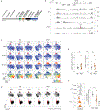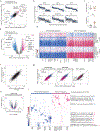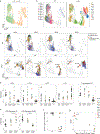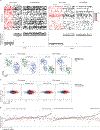Single-cell analysis of FOXP3 deficiencies in humans and mice unmasks intrinsic and extrinsic CD4+ T cell perturbations
- PMID: 33833438
- PMCID: PMC8173714
- DOI: 10.1038/s41590-021-00910-8
Single-cell analysis of FOXP3 deficiencies in humans and mice unmasks intrinsic and extrinsic CD4+ T cell perturbations
Abstract
FOXP3 deficiency in mice and in patients with immune dysregulation polyendocrinopathy enteropathy X-linked (IPEX) syndrome results in fatal autoimmunity by altering regulatory T (Treg) cells. CD4+ T cells in patients with IPEX syndrome and Foxp3-deficient mice were analyzed by single-cell cytometry and RNA-sequencing, revealing heterogeneous Treg-like cells, some very similar to normal Treg cells, others more distant. Conventional T cells showed no widespread activation or helper T cell bias, but a monomorphic disease signature affected all CD4+ T cells. This signature proved to be cell extrinsic since it was extinguished in mixed bone marrow chimeric mice and heterozygous mothers of patients with IPEX syndrome. Normal Treg cells exerted dominant suppression, quenching the disease signature and revealing in mutant Treg-like cells a small cluster of genes regulated cell-intrinsically by FOXP3, including key homeostatic regulators. We propose a two-step pathogenesis model: cell-intrinsic downregulation of core FOXP3-dependent genes destabilizes Treg cells, de-repressing systemic mediators that imprint the disease signature on all T cells, furthering Treg cell dysfunction. Accordingly, interleukin-2 treatment improved the Treg-like compartment and survival.
Conflict of interest statement
COMPETING INTERESTS STATEMENT
The authors declare no competing interests.
Figures








References
-
- Wing JB, Tanaka A, & Sakaguchi S. Human FOXP3+ regulatory T cell heterogeneity and function in autoimmunity and cancer. Immunity. 50, 302–316 (2019). - PubMed
-
- Hill JA et al. Foxp3 transcription-factor-dependent and -independent regulation of the regulatory T cell transcriptional signature. Immunity. 27, 786–800 (2007). - PubMed
Publication types
MeSH terms
Substances
Supplementary concepts
Grants and funding
LinkOut - more resources
Full Text Sources
Other Literature Sources
Medical
Molecular Biology Databases
Research Materials

